Weekend
getaway series, no. 43,237
Kristin's only here for a few more days, so we
need a high-yield destination that's pretty close by.
You
may not find this terribly rewarding unless you're included here, so this is a
good time for casual and random browsers to turn back before they get too caught
up in the sweep and majesty of the proceedings and can't let go.

So
here we are in the Milan Centrale train station, 22 February 2008, with an armful
of The Guardian, The Independent, and the trusty old Herald Tribune (and Lamb:
the Gospel According to Biff for a backup), and a few moments to kill
for the connection to Bergamo. The Cisalpino out of Switzerland is a joy to glide
quietly along in; the regional to Bergamo is a rusty, sputtering jitney.

Here's
our flat, the casa vacanze Maura in the Città
Alta, or walled upper city, the historical centre (not to be confused with the
Città Bassa, the lower city, mainly 19th-early 20th century, not bad in
general terms, but pretty city-ish).

Maura has been brilliantly restored, one of three vacation apartments in the Città
Alta operated by the extremely friendly and helpful Mario Pozzoni -- the other
two are called Eulalia and Nastassia
after his daughters.

The
courtyard entrance in the back

Kristin,
decked out in our courtyard to set off for some serious sightseeing.

The
front of the Maura facing onto Vagina Street. Sorry about that, we didn't name
it. It's the Via Del Vagine, 6.

Just
next to the ancient disused city prison.

The
far end of the Via Del Vagine and . . .

.
. . the short jog up the Via Tassis to the Via Colleoni, the main street that
runs the length of the Upper City, and the Upper City centre at the Piazza Vecchia.

The
Piazza Vecchia, overlooked by a Po Valley wintertime
sky and, at the far end, the allegedly fabulous Palazzo della Ragione. . . completely
under wraps. The Contarini fountain is in the centre.
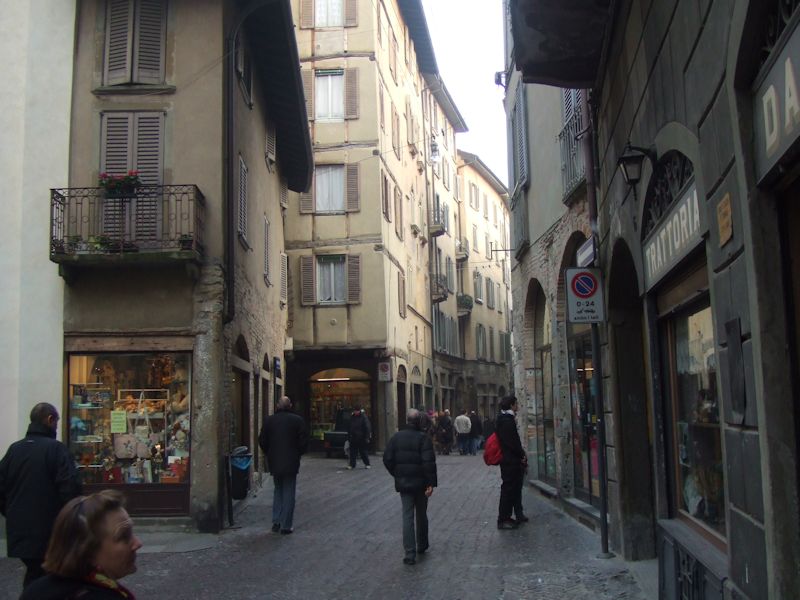
The
Via Colleoni, the main east-west thoroughfare through
town.

Late
afternoon perambulations around the Città Alta

Near
the Piazza Mercato delle Scarpe

The
Piazza Mercato delle Scarpe, but with no shoe stores
in sight these days, and on the far side, the top of the funicular rail line down
to the Città Bassa.

An
official indication that pedestrians are welcome.

Modern
Italy: an ancient statue
and a shiny new Fiat.

The
church of Santa Maria Maggiore, begun in the 12th
century, the spring of 1137 to narrow that figure down a bit.

Note the lions guarding the door -- very historical, and very Venetian (St. Mark,
etc.). Bergamo ('mountain house' in Cenomani Celtic) became a Roman town in 49
B.C. but got trashed by Attila the Hun in the 5th century. It bounced around for
some 6 or 7 centuries as a Lombard duchy, a county seat under Charlemagne circa
800, and an independent city-state in the 12th century. The Visconti of Milan
got their hooks into the place in the mid-13th century, were thrown out by the
famous military contractor, then called a condottiere, Bartolemeo
Colleoni, and came back in force in the mid-14th. Eventually, Garibaldi
threw off the Bergamasks' shackles in 1859, you'll be pleased to learn, and ever
since the town has been part of Italy.

In
the meantime, however, the Venetians came along in 1428 and took matters in hand
briskly, and that's why there are St. Mark's lions strewn underfoot, Venetian
fortifications all round the outside of it, the fortress Rocca at one end of town,
and a fountain in the main square built by the Venetian podestà Alvise
Contarini. Kristin loves a good stone lion.

The
baroque interior of Santa Maria Maggiore (shot with
a shaky hand in ambient light, so as not to disturb the religious folks), way
too decorated for some of us, but
it's got some excellent 14th century and also Tiepolo frescoes and some wood marquetry
panels from Lorenzo Lotto.


How inspiring these ceiling narratives would be if we'd brought our opera glasses.


-- No begging.

Kristin
especially loves red marble Venetian lions and trusts them with her hand.

The
red lion door of the basilica di Santa Maria Maggiore is the little door on the
left -- the big thing with the rose window is the Colleoni
chapel, built by the native-son military contractor and very Renaissancy,
and with a prominent funeral urn inside which may be Bartolomeo
Colleoni himself. Or an imposter.

The
old city fathers still keep a watchful eye on things from the ancient city hall.

A
penitent pilgrim asking all the right questions, but still, so far, no answers.

To
every streetcorner its own bell tower

-- I'm
sorry. I'm really, really sorry.
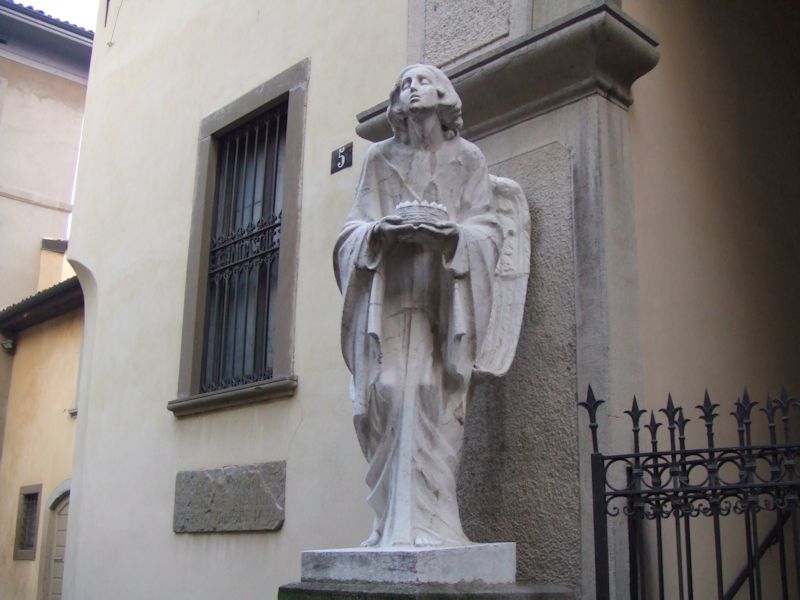
"Penny
for the Old Guy?"

Bette
Davis played this role in her later years.
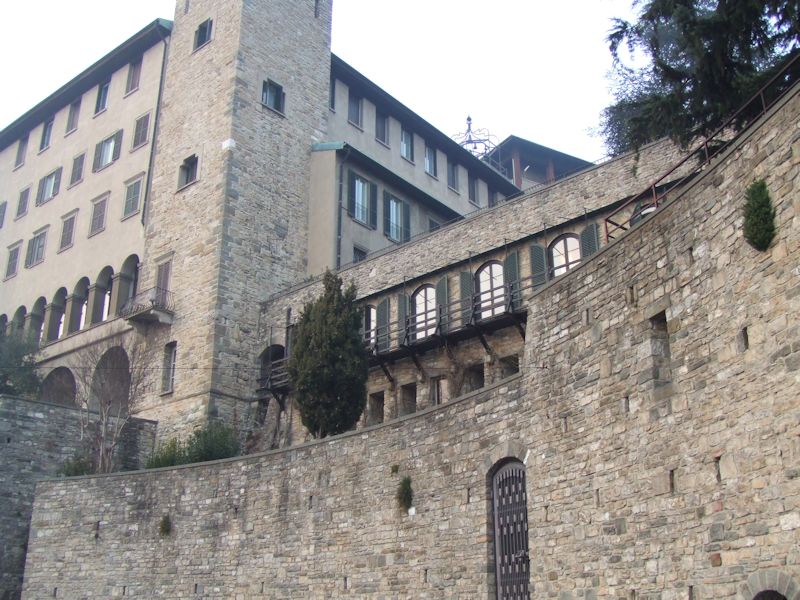
Angelo
Giuseppe Roncalli was
born in the region in 1881 and made good for himself, under the stage name or
nom de guerre "John XXIII". Part of his legacy, along with the Second
Vatican Council, is this humongo seminary, doubtless training up countless new
potential popes 'even as we speak', as the Americans would say. Knowledgeable
friends tell me that this fellow is the Papa Buono, the "good pope",
which I find encouraging.

Good Popes
aside, this strikes me as a still more elemental symbol for religion -- high tech
sculpture, ancient astrolabey sort of thing, and a tired old sun.

"Good
Pope" may be oxymoronic, but Pope John XXIII's fortress seminary, training
new priests or whatnot, looks able to withstand any attacks with conventional
weapons.

Kristin
slipping unobtrusively through one of the several robust and beautiful city gates,
Porta San Alessandro.

Back
home to our temporary digs with a snack of goodies from the tiny, charming alimentaria-enoteca-salumeria
on the Via Tassis. Chiefly prosciutto di parma ("18 months!"), inexpensive
Barbera red, and a number of cheeses that came with a manual.

And
now, suitably fortified, out Vagina Street for dinner.

Venetian-era
battlements at the foot of the Via San Lorenzo, as we set out on Saturday to find
some Art.

Here's
a quick view of the Città Bassa as the fog/smog cleared briefly. Only
120,000 souls are pursuing their dreams here, merely a village by the standards
of a megalopolis like Geneva canton with 450,000.

The
Città Alta: Voi siete qui - You are here
(orange dot on the right), as we're heading down to the Accademia Carrara to find
some Art. The pink dot that looks like it doesn't
really belong on this map indicates our flat on the Via Del Vagine. The Piazza
Vecchia central square is in the centre and the main funicular cable car is shown
as white dots. The second funiculaire, up to San Vigilio, is on the extreme left.

The
church of San Agostino. Not really, that was a joke,
it's "decommissioned" (like Kristin's flat
in Boston). Now it's part of the university, with some Asian students heading
in for the science lessons. Another excellent use for religion.

The
back of San Agostino, a really well-defended university. If there had been walls
like that around American universities in 1970, US history might have turned out
less unpleasantly than it has.

Here
we are at the Pinacoteca dell'Accademia Carrara (Accademia
Carrara for short), to view ART, but not at
LUNCHTIME (until 14:30). Come back later. So we're
off down the smoggy streets in the Città Bassa to find some newspapers,
but it's more smog than English newspapers there, so we'll while away the idle
hours with some contemporary art instead, or a burrito
if we can find a Mexican sidewalk stand.

Just
across the street, the Galleria d'Arte Moderna e Contemporanea,
with a special exhibit on Il Futuro del futurismo,
or the future of futurism -- "200 works by 120 artists reflect and express
the influences exerted by Futurism on the developments of visual art from the
19th century up to the present day". It was alas a fat lot of bollocks to
me, even the so-called "Damien Hirst", but then I'm a thorough philistine
on these post-17th century matters. And I got in free anyway, a special category
for seniors and students; evidently they took me for a student.
I
would have recommended that you have a go at it anyway, but we were there on the
last day of the exhibit. God knows what's next. Skinned cadavers, maybe.

Enough
of that! It's 14:30, time for the Accademia Carrara staff to toss back the last
of their lunchtime chianti and get back to the security stations. This is a wonderful,
manageably small collection, 13th century to 19th, of excellent locals and a few
major hitters, like Mantegna, Fra Angelico, Botticelli, and some Dürers that
we walked right past without noticing and had to go back for. Down the middle
of the gallery was a strange, unrelated exhibition of the history of famous Italian
brand names, with shoes, motor-scooters, Bianchi bicycle frames, hats and corsets,
diningroom furniture, I lost track after a while and was just trying to step over
them to see the Mantegna without knocking over mannequins in bright neckties
and glittery sunglasses.

The
Porsche run from the Città Alta to the Città Bassa, a speed record
on cobblestones

We
asked local residents what this one is all about, but they looked away quickly
and refused to speculate. It probably commemorates some local event many years
ago.

Why
plod all the way back up the hill when there's an 1880s cable-car up it, nearly
free! In fact, entirely free for me -- almost better than getting the student
pass into the Accademia again.

Kid
and Pigeon, classic tableau.
Kristin's in the pharmacy in the background, stocking up.

Near
the Mercato delle Scarpe -- Kristin, who loves shoes
more than is wise or healthy, was disappointed to find that the name is a medieval
artefact.
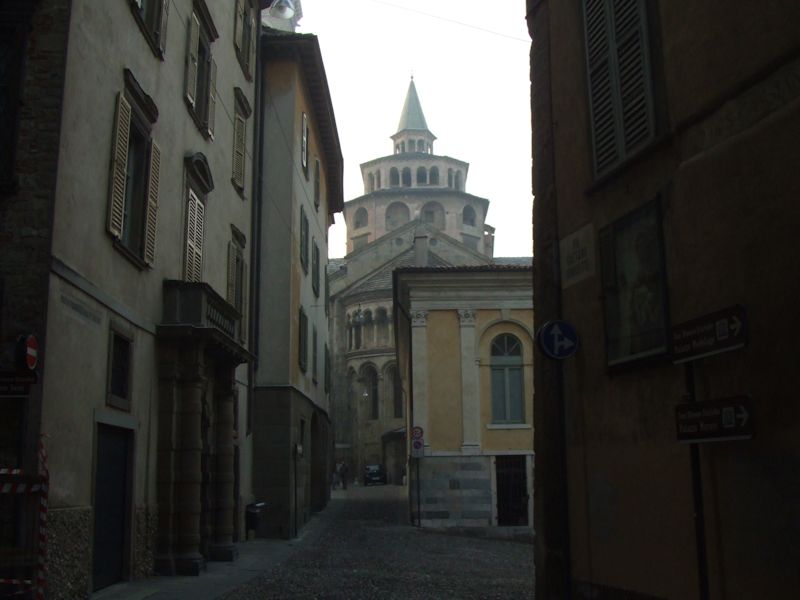
More
churches looming

Kristin's
latest encounter with the police. It went off without a hitch.

Layers
and levels

More
layers and levels, just a lot of verticality.
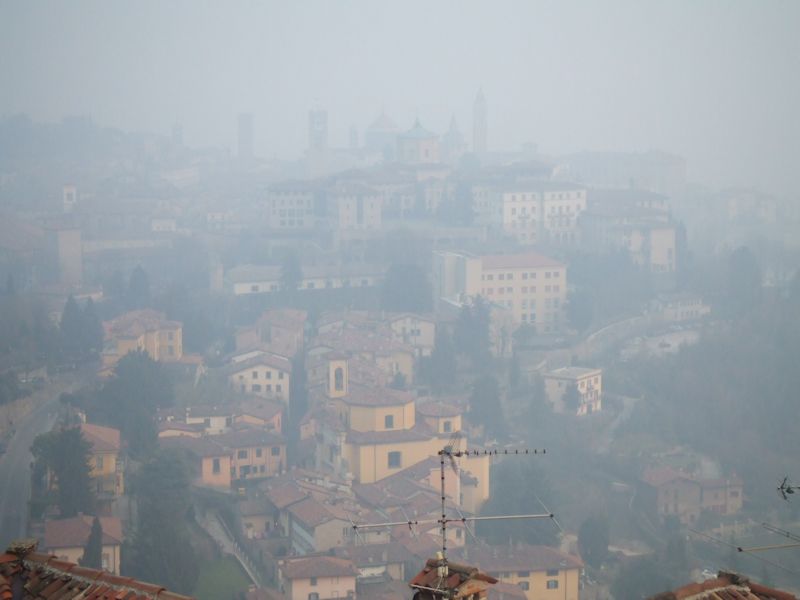
The
Upper city, in Po Valley winter air, from the Upperer Upper City, the top of the
funiculaire rail car to San Vigilio, topped by an
old fortress with a sign, at the top of a 200-metre staircase, that said "closed".
The signboard at the bottom of the staircase had nothing on it.

Kristin
featured here, passing out of the Citadella, the Visconti era fortress at the
western end of the town (not far from Via Del Vagine)

The
Via Colleoni again, near nightfall: we were looking
for soy milk, if you can believe that, and each of the shopkeepers directed us
to another likely possibility, and sure enough we found some.

Our
favored restaurant throughout, Il Sole, right on
the central square Piazza Vecchia -- beautiful within, good prices, good stuff
for your mouth I'd say, a functionally friendly if not genuinely warm staff, and
owned by the wife of our charming host Mario, so Why go elsewhere?

A kodak moment

Time
for an apéritif with some prosciutto di Parma, fancy cheese, and speculations
about tonight's dinner. An hour or so with the current Scientific American before
we need to wrestle on the old tux.

Next
day: The Campanone, or Civic
Tower (Torre Civica), a 12th century edifice that has been mocking us from
high above since we arrived -- and now an hour before departure, we're going up
it or die in the attempt!!!!
Luckily,
it was open on Sunday morning, AND free for me, AND
it's got an elevator nearly to the top. So we're all set.

From
the civic tower back down into the Piazza Vecchia, with its Contarini fountain,
its rather awkward 17th century Biblioteca Angelo Mai dominating the fourth wall
ponderously, and a construction crane borrowed from Dubai, where nearly all the
world's construction cranes have gone to seek their fortunes.

The
pope's seminary high on the left, the Cittadella on the right . . .

and
the cable-car and fortress of San Vigilio in the
background.

The
fortress of Rocca in the other direction

The
Duomo or cathedral

The
Basilica of Santa Maria Maggiore

The
Colleoni Chapel and, in the lower right, the 14th
century baptistry (with the excellent floor) that was allegedly moved out here
from the inside

Looking
past the Duomo out over the lower city. See it there? In the background!

Santa
Maria Maggiore
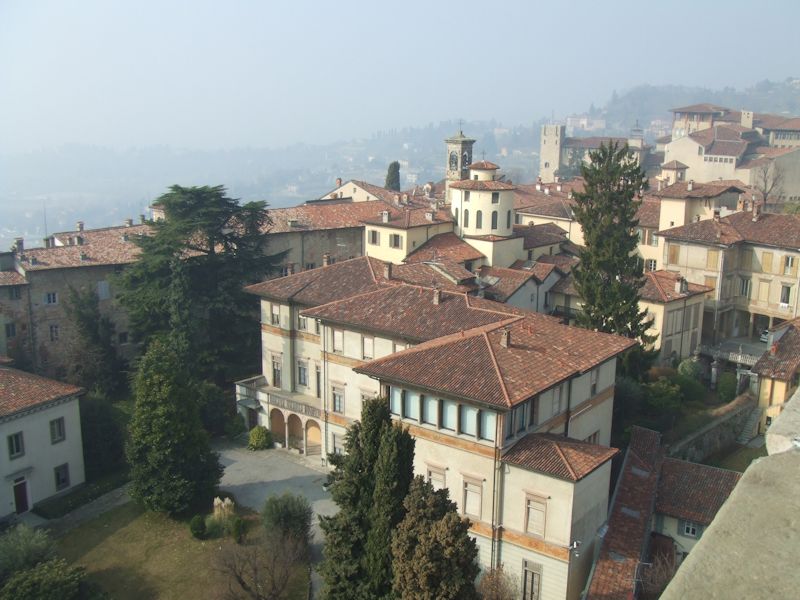
Time to redescend

The
Contarini fountain with the Venetian lions and the
guy throwing up

The
Civic Tower again. The bell rings out, supposely
over 100 times, at 10 p.m. every evening, formerly to announce the city curfew,
now just to be historical and infuriate people.

Now
we're dashing back to the flat for some hasty packing. Our host is going to
ferry us back down to the rail station, bless him.

And
tidying up the flat before we leave.
(The TV, though
we didn't use it, is neat -- the gyroscopic antenna on the top of it rotates around
when you change channels to find the appropriate signal. Watching the antenna
was more fun than watching the TV.)

Kristin
and our host, Mario, headed for his car, with which he and his daughters are going
to drive us down to the train station.

The
gate of the citadel at the end of Via Colleoni --
a valedictory look at it, and the occasion for a poem about it.
The
poem, however, got left in the train at an advanced stage of refinement. It began
"O! Yon Tower!" but the rest is lost.

The
appallingly big Milan train station, where at noon on Sundays the nearby residents
come out to enjoy the fresh air and drink beer.

And
now it's back to "Ginevra" and, tomorrow, back to work -- and for Kristin,
back to the height of the opera season in Boston.